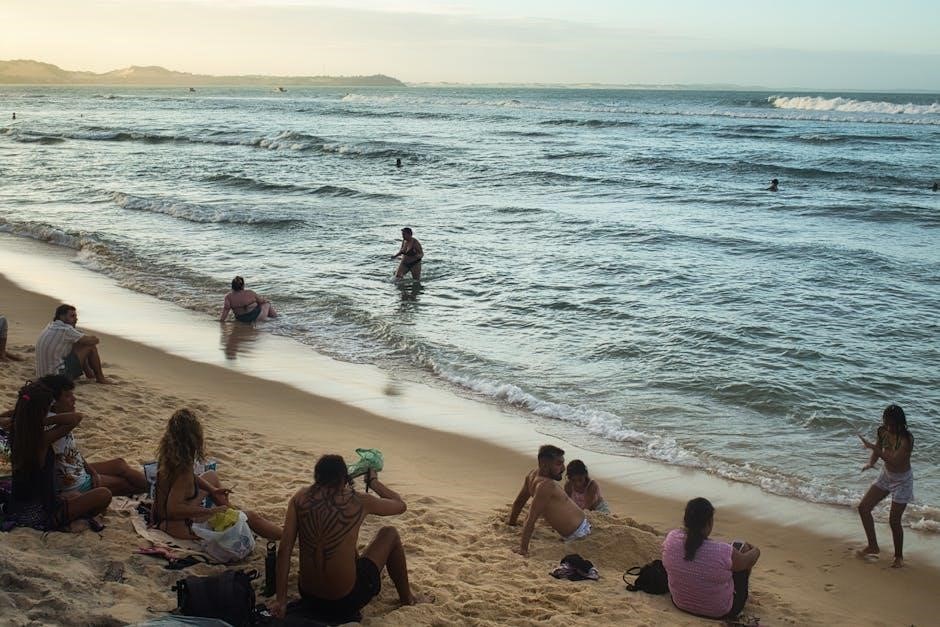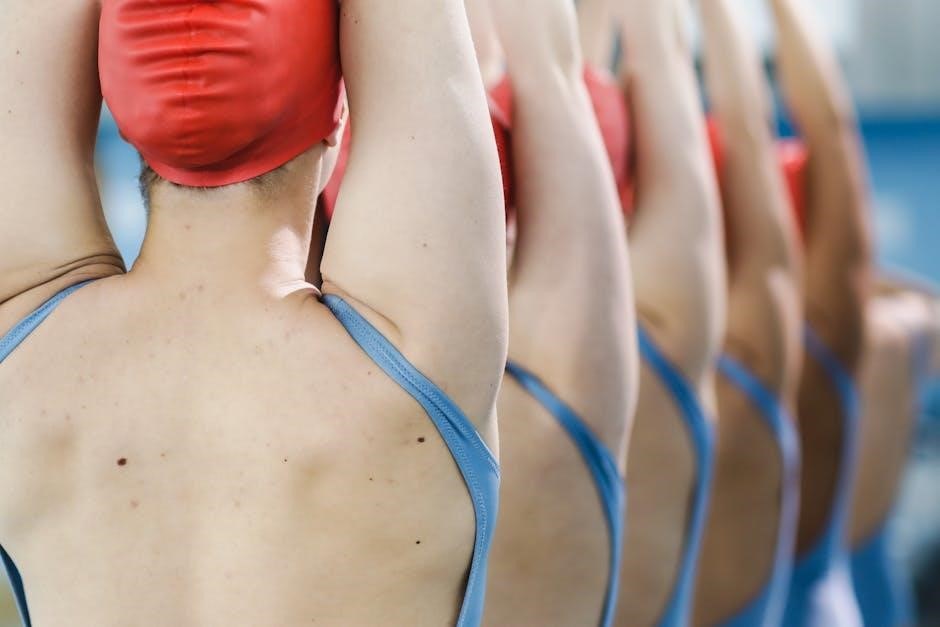Definition of Age Group Swimming
Age group swimming refers to a category of competitive swimming where participants are divided into groups based on their age‚ with the aim of promoting healthy competition and skill development among young swimmers.
This age-based grouping allows for a more level playing field‚ enabling swimmers to compete against peers of similar age and ability‚ and providing a framework for tracking progress and improvement over time.
The age group swimming category is typically divided into several sub-groups‚ each spanning a specific age range‚ such as 8 and under‚ 9-10‚ 11-12‚ and so on‚ with each group having its own set of rules‚ regulations‚ and competition formats.
By participating in age group swimming‚ young athletes can develop their swimming skills‚ build confidence and self-esteem‚ and learn valuable life skills such as teamwork‚ discipline‚ and sportsmanship‚ all of which are essential for success in both swimming and other areas of life.
Age group swimming also provides a platform for swimmers to progress to higher levels of competition‚ such as national and international events‚ and to pursue their swimming careers with greater focus and determination.

Benefits of Age Group Swim Workouts
Age group swim workouts improve physical fitness‚ enhance mental toughness‚ and boost overall well-being for young swimmers every day with effective training methods.
Improved Stroke Efficiency
Improved stroke efficiency is a key benefit of age group swim workouts‚ allowing young swimmers to conserve energy and swim faster.
With the help of drills and exercises‚ swimmers can develop proper technique and reduce drag in the water‚ resulting in more efficient strokes.
This is achieved through a combination of kick drills‚ arm drills‚ and full-stroke swimming‚ all of which help to identify and correct inefficiencies in the swimmer’s technique.
By improving stroke efficiency‚ young swimmers can swim longer distances without getting tired‚ and also improve their overall performance in competitions.
The use of swim workouts pdf can provide coaches and swimmers with a wide range of drills and exercises to help improve stroke efficiency‚ making it an essential tool for any age group swim team.
With consistent practice and training‚ young swimmers can develop efficient strokes and achieve their goals in the pool‚ whether it’s to improve their times or simply to have fun and stay active.

Types of Age Group Swim Workouts
Various types of workouts include endurance‚ sprint‚ and technique drills‚ utilizing swim workouts pdf for customized training sessions every day.
Beginner-Friendly Workouts
Beginner-friendly workouts are designed to introduce young swimmers to the world of competitive swimming‚ focusing on building endurance and technique. These workouts typically involve shorter distances and drills that help develop basic swimming skills. According to various swim workouts pdf‚ beginner-friendly workouts often include kicking drills‚ arm circles‚ and breathing exercises to help young swimmers build confidence in the water. The workouts are usually structured to be fun and engaging‚ with an emphasis on learning and improvement rather than competition. By starting with beginner-friendly workouts‚ young swimmers can develop a strong foundation in swimming and progress to more advanced levels as they gain experience and build their skills. The goal of these workouts is to create a positive and supportive environment that encourages young swimmers to learn and grow‚ while also preparing them for more challenging workouts in the future. This approach helps to build a lifelong love of swimming and promotes a healthy and active lifestyle.
Advanced Workouts
Advanced workouts are designed for experienced young swimmers who have already developed a strong foundation in swimming. These workouts‚ as outlined in various age group swim workouts pdf‚ focus on refining technique‚ increasing endurance‚ and building speed. They often involve more complex drills and sets‚ such as interval training‚ sprinting‚ and endurance swimming. The goal of advanced workouts is to challenge young swimmers and help them reach their full potential‚ preparing them for competition at the highest levels. Advanced workouts may also include strength training and conditioning exercises to help young swimmers build the physical strength and endurance needed to compete at an elite level. By providing a challenging and engaging workout environment‚ advanced workouts help young swimmers stay motivated and focused‚ while also promoting a healthy and active lifestyle. With advanced workouts‚ young swimmers can take their swimming to the next level and achieve their goals in the pool. This level of training requires dedication and hard work.

Sample Age Group Swim Workouts
Sample workouts include drills and sets‚ found in age group swim workouts pdf‚ to improve technique and efficiency for young swimmers daily with proper training and guidance always.
Workout 1
Workout 1 is designed to improve freestyle technique‚ with 12 x 25 freestyle long axis drills‚ focusing on proper body position and arm movement.
The drills are followed by 1 x 100 free swim with a snorkel‚ emphasizing long and strong control‚ and 8 x 50 kick choice‚ targeting specific muscle groups.
This workout is crucial for young swimmers‚ as it helps build a strong foundation in freestyle‚ one of the most common strokes used in competitions.
The use of a snorkel allows swimmers to focus on their arm movement and body position‚ without the distraction of breathing.
The kick choice segment enables swimmers to work on their leg strength and technique‚ essential for a powerful freestyle.
By incorporating these drills and swims into their training‚ young swimmers can improve their overall technique and efficiency in the water‚ leading to faster times and better performance.
The workout is structured to be challenging yet manageable‚ allowing swimmers to build confidence and endurance.
With consistent practice and dedication‚ swimmers can master the skills taught in Workout 1 and move on to more advanced techniques.
The age group swim workouts pdf provides a detailed outline of the workout‚ including warm-up routines and cool-down stretches‚ to ensure a safe and effective training session.

Coaching Tips for Age Group Swim Workouts
Coaches should provide positive feedback and encouragement to young swimmers during age group swim workouts to build confidence and skills effectively every day online.
Dividing the Team
To effectively manage a large team of young swimmers‚ coaches can divide them into smaller groups based on their skill level and age‚ allowing for more personalized attention and instruction during age group swim workouts. This approach enables coaches to tailor their training sessions to meet the specific needs of each group‚ helping to improve overall performance and efficiency. By dividing the team‚ coaches can also encourage healthy competition and teamwork among the swimmers‚ fostering a positive and supportive team environment. Additionally‚ this approach can help to reduce congestion in the pool‚ allowing each swimmer to have more space to practice and refine their techniques. With a well-structured and divided team‚ coaches can create a more productive and enjoyable training experience for all participants‚ ultimately leading to better results and a stronger team dynamic; Effective team division is a crucial aspect of successful age group swim workouts.
Encouraging Fun and Efficiency
Coaches play a vital role in encouraging fun and efficiency during age group swim workouts‚ creating an environment that promotes learning and enjoyment. By incorporating games and interactive drills into their training sessions‚ coaches can help young swimmers develop their skills while having fun. This approach can also help to build confidence and motivation‚ encouraging swimmers to push themselves and strive for improvement. A positive and supportive team culture is essential for fostering a love of swimming and promoting long-term participation. Coaches can use various techniques‚ such as providing constructive feedback and recognition‚ to encourage swimmers and help them reach their full potential. By striking a balance between fun and efficiency‚ coaches can create a training environment that is both enjoyable and productive‚ helping young swimmers to develop a lifelong passion for swimming and achieve their goals. This approach is essential for successful age group swim workouts.

